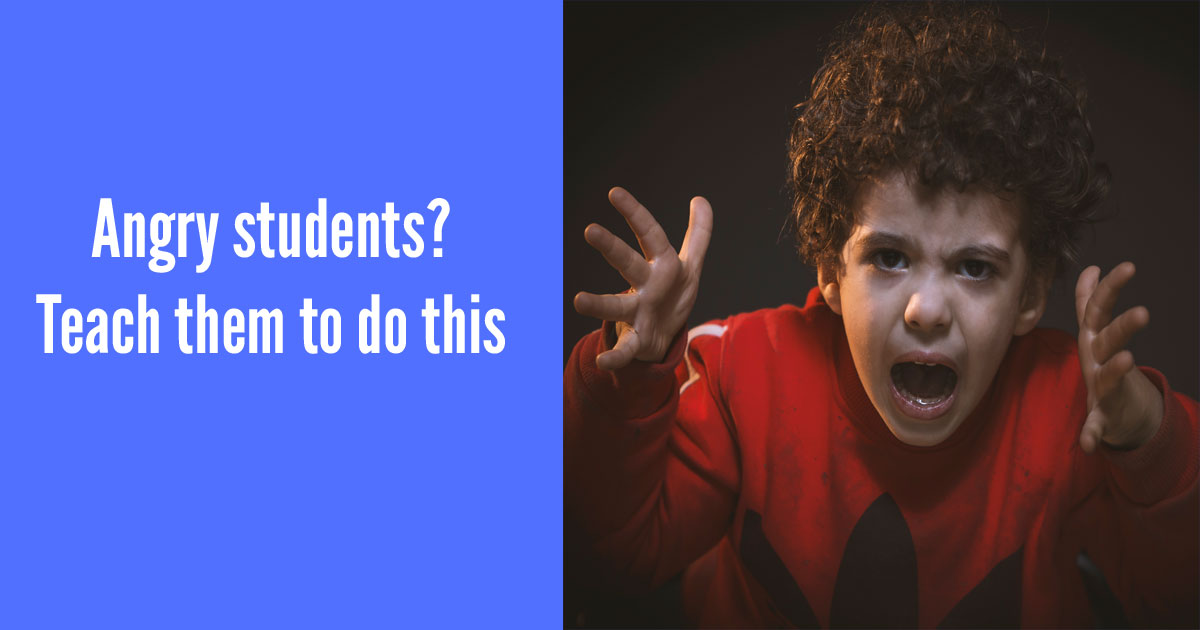There are more and more students bringing anger issues into the classroom.
These explosive behaviours can be frightening for the other students to watch. Not to mention stressful for us.
But is there anything we can do to support students who can’t control their emotions?
There is. Before I get to that, I want to look at the standard approach to managing anger in schools and why it’s less likely to be successful.
The ‘stable-door’ approach
The normal approach is to get the student to focus on how they should behave after they’ve lost control.
Stay safe stuff, like:
- going to a safe space
- finding a key adult to talk to
- breathing / mindfulness exercises
- counting to 10
But this is likely to fail.
Here’s why: when a student enters an anger state, they’re entering ‘survival mode‘. This is a set of behaviours humans evolved tens of thousands of years ago to survive in the wild.
It’s designed to keep us alive in the face of life-or-death threats.
Here’s an example: we wander out of a cave and bump into a lion. The part of our brain called the amygdala immediately detects the threat and acts like a firm alarm. It warns the body of an immediate danger and kick-starts a fight-or-flight reaction.
The fight-or-flight response primes our bodies to:
- fight the lion, if we fancy our chances…
- …or run away, as quickly as possible
So, fight-or-flight is about survival in life-or-death situations.
The out-of-control students in our classrooms are reacting in the same way. It’s like their biology is misfiring. They’re reacting to small problems (‘you’ve forgotten your homework’) as if there’s a lion in the room.
(We won’t worry about why for now.)
The thing is, whenever someone enters this state, it affects how their brains process the world. They become very focused on the ‘now’. They stop processing language effectively and concentrate almost entirely on the ‘threat’.
They stop thinking about:
- whether they’re going to lose golden time the end of the week
- where their safe space is
- what their targets are
- what their parents will say at the end of the day
- taking deep breaths / counting to ten
Their bodies have taken over. They’re acting like there’s a lion in the room.
So strategies that encourage the student to take the ‘right’ behaviour after they’ve become angry… are much less likely to succeed. It’s just too late in the game.
Those students are just not in a place where they can use those strategies. They’re not thinking logically or calmly. In fact, they’re hardly thinking at all. They’re reacting.
The stable-door is wide open and the horse has bolted.
So is there a better approach? There is. The solution is…
Teach them to not get angry in the first place
Obviously, that’s harder than it sounds…
But the point stands. We need to teach our pupil to take action whilst they are in a state to make good decisions. Before they hit fight-or-flight. We do that by rewiring their habits – and that takes effort, time and repetition.
(Sorry if you were looking for a instant solution/silver bullet – but stay with me.)
Here’s the process.
1. Improve their self-awareness
The first step is to get our students to become more aware of their thoughts and feelings.
That means teaching the pupil a range of emotional vocabulary. This is because many students with anger issues use limited, binary language to describe how they feel – they’re okay or their angry. There’s nothing in between.
Our aim is to broaden that language. We have to teach them that emotional language has a scale, or a range, like the volume control on a speaker. For instance, before we get to ‘anger’, there’s also frustrated, annoyed, upset etc.
Then, we get them to ‘check in’ and self-report their emotions frequently – ie. hourly. This improves their self-awareness because they’re continually self-monitoring their emotional state.
(Check out this article for more about the benefits of ‘checking-in’.)
2. Reading the road
Once they can do this, we guide our student through a similar process for triggers.
The first part of this process involves getting the student to write down the triggers that spark their emotions. They identify the exact word for the emotion, and the size/scale of that feeling as a number (eg. out of 10).
Then we get them to agree proportionate strategies in response to those triggers. People who are ‘frustrated’ react in a different way than those who are ‘enraged’.
The last step is to get them into the habit of scanning for those triggers throughout the day.
Scanning for triggers is like driving a car down a busy road. We don’t just drive ahead blithely, paying no attention to the out-of-control car screeching towards us, swerving at the last moment before impact.
We scan the road ahead, watching for unexpected behaviour and possible dangers. Then, if we spot a danger, we can take early evasive action… with our actions being less dramatic as a result.
In the same way, we encourage our students to look for up-coming anger triggers throughout the day. Then they can take evasive action of their own – whilst they’re still calm and in control.
This is much more likely to succeed because the student’s biology hasn’t triggered the fight-or-flight response yet. Meaning they’re more able to take rational and proportionate decisions.
And that’s the key to this approach: avoiding survival mode (their ‘anger’ state) entirely.
Which is better for everyone: the student, their classmates, and the adults managing them.

